The Big Read: A charmed life in Pyongyang, despite crippling sanctions
PYONGYANG — From curved 4K televisions to Android tablets to self-wringing mops — the throngs of North Korean shoppers were spoilt for choice as they browsed through the myriad of consumer goods on display at a trade fair in Pyongyang recently.
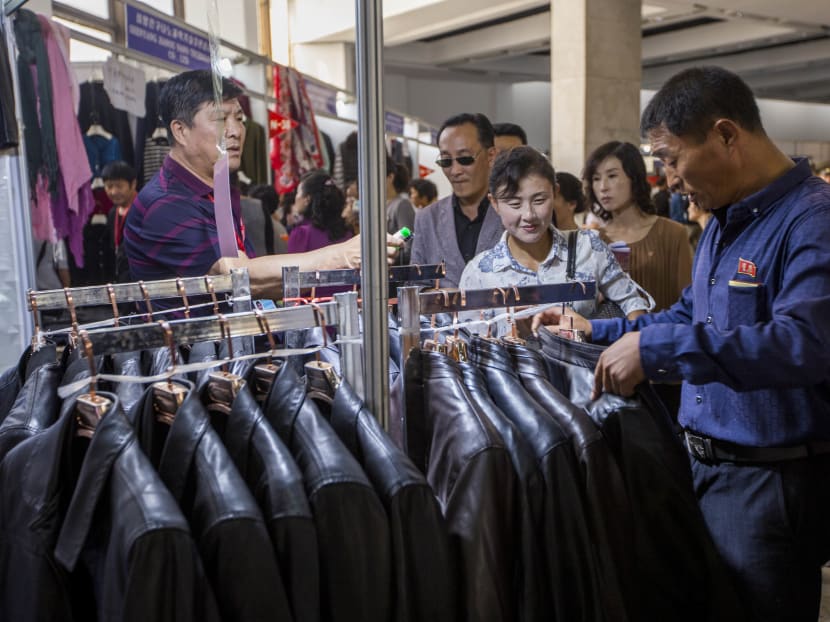
A Chinese salesman (left) selling leather jackets at the 14th Pyongyang Autumn International Trade Fair on Sept 20, 2018.
PYONGYANG — From curved 4K televisions to Android tablets to self-wringing mops — the throngs of North Korean shoppers were spoilt for choice as they browsed through the myriad of consumer goods on display at a trade fair in Pyongyang recently.
And should they need a ride home along with their purchases, they could flag down their choice of taxi brands which now ply the once-quiet roads of the North Korean capital.
Instead of showing signs of stress caused by years of international sanctions due to North Korea’s weapons programme — which have exacted a heavy toll on the overall economy — Pyongyang seemed to be a city of the affluent and the nouveau riche.
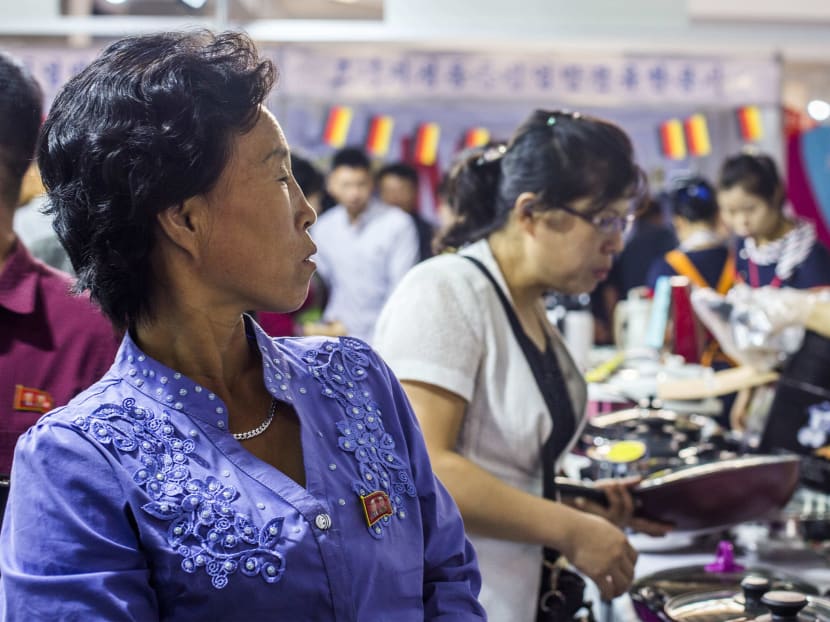
Take the case of the international trade fair held this month, which attracted strong business and consumer participation.
None of the more than 30 Singaporean companies which had participated in the biannual fair previously were present this time, as they took a more cautious stance in view of tightened United Nations’ (UN) sanctions on North Korea.
Yet, the organisers still had to turn away dozens of other interested exhibitors as there were simply not enough booths to accommodate demand, even though the fair grounds had been extended from the original exhibition hall — which is larger than the size of a football field – to the outdoors with the setting up of makeshift tents.
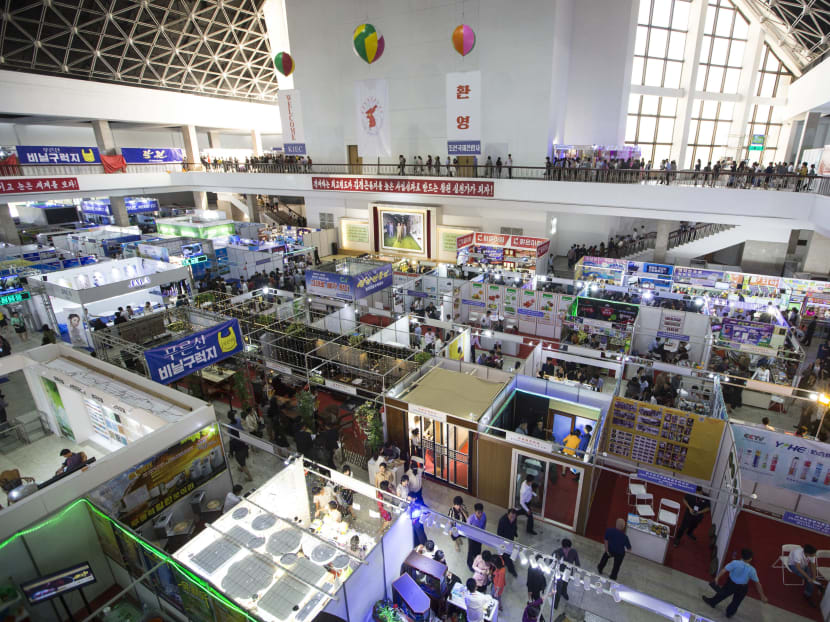

Then, there is a four-storey complex at Pyongyang’s Phyong Chon district, called Sentosa Business Centre, built by a Singaporean businessman. He has gone on an indefinite hiatus since November last year, leaving his North Korean general manager, Madam Ju Sun-bok, to run it on her own.
The centre is structured like a working men’s club with a restaurant, hair salon, massage parlour, spa, sauna, gym and meeting room to discuss business deals. It operates with a staff of more than 20 North Korean workers who are each paid a starting salary of US$50 (S$68) a month. According to the locals, such a sum is considered to be reasonable since housing, medical care and education are free.



Indeed, despite the crippling sanctions, the side of Pyongyang that TODAY was presented with — when this reporter accompanied a Singaporean delegation of eight businessmen there last week — pointed to a growing consumer class in the hermit kingdom. The delegation was in the capital at the invitation of the Korea Committee for the Promotion of International Trade.
SIGNS OF A NOUVEAU RICHE
Throughout the four-day trade fair, long queues could be seen at the gate leading to the exhibition hall, as more than 5,000 North Koreans descended daily, money in hand and more than willing to pay the US$0.50 entrance fee to begin their shopping spree.
Some were seen arriving in taxis, now widely available for hire at a base price of US$2, followed by a charge of US$0.50 per kilometre thereafter.
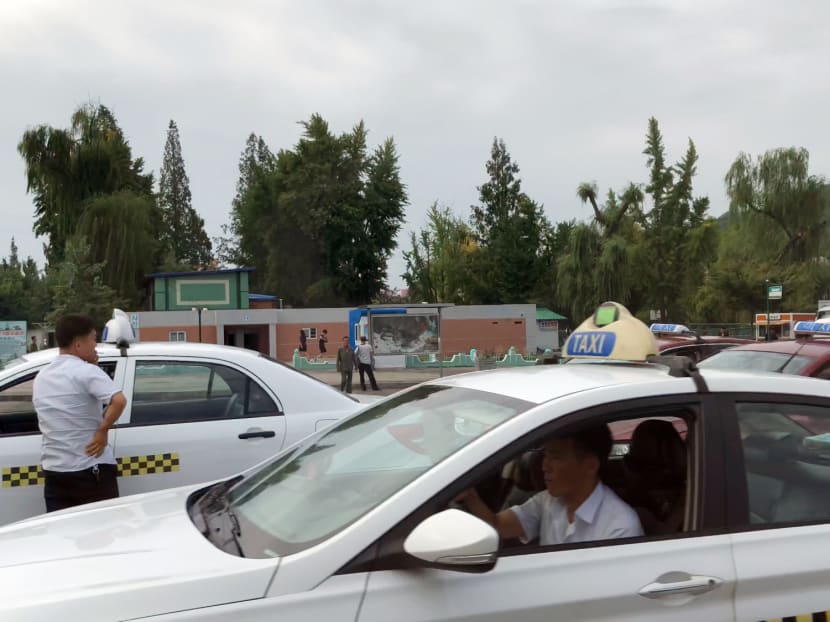
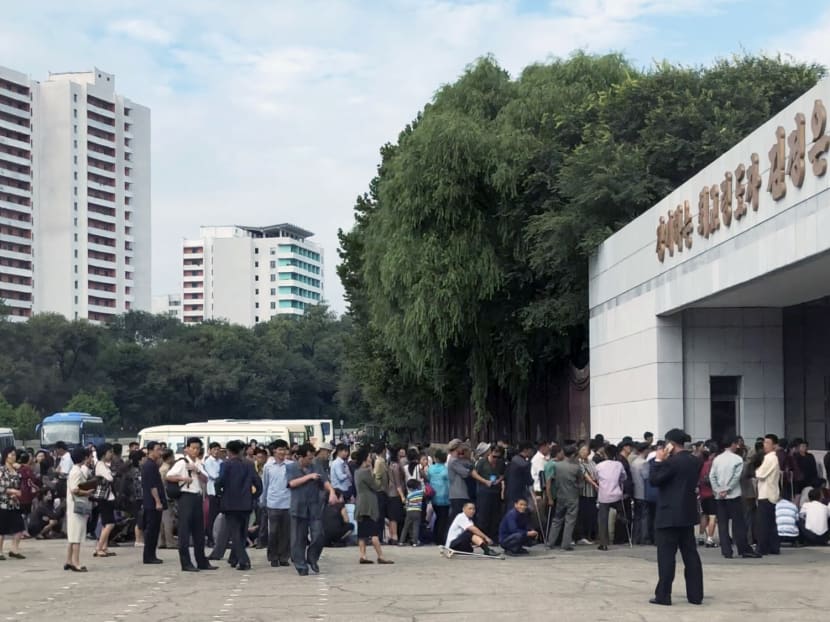
Inside the hall, Chinese salesmen took centre stage, enticing the Koreans with products such as self-wringing mops (with prices slashed from US$30 to US$20) and magnetic window cleaners (US$10). Deals were rapidly sealed in broken Mandarin, and paid for in mainly Chinese yuan or US dollars.
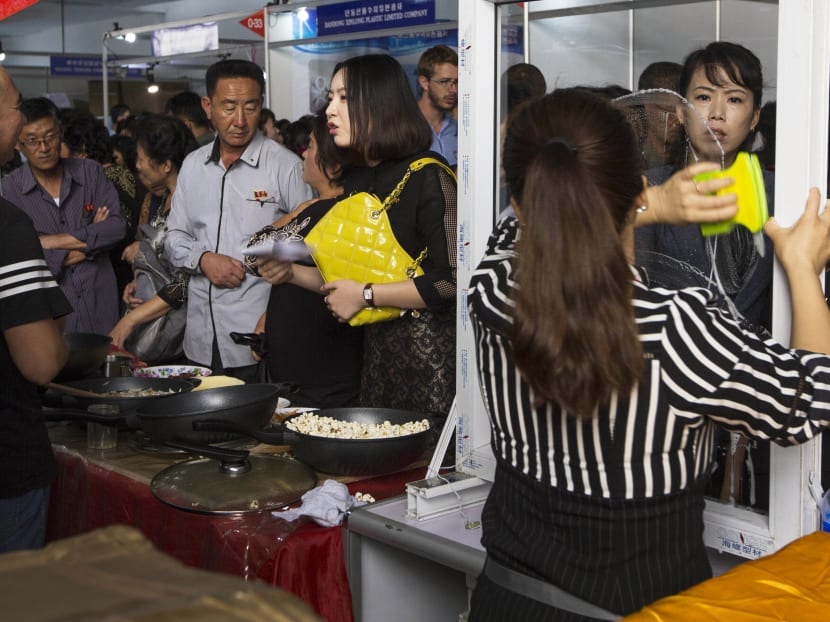
North Korean exhibitors showcased electric appliances, beauty products (a block of Ginseng soap for US$0.50), health supplements, jewellery, ornamental lights and aquarium tanks, while their US$10 to US$20 handbags sold like hotcakes.
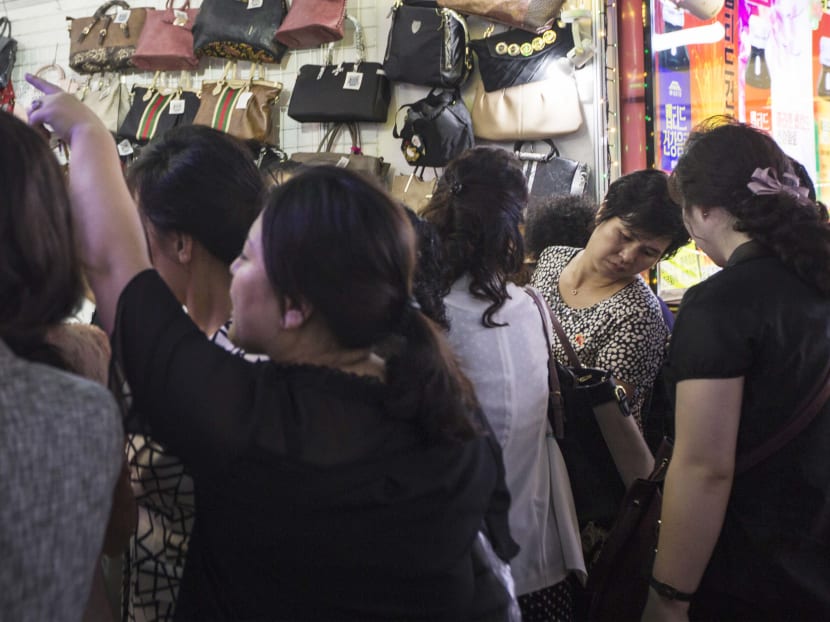
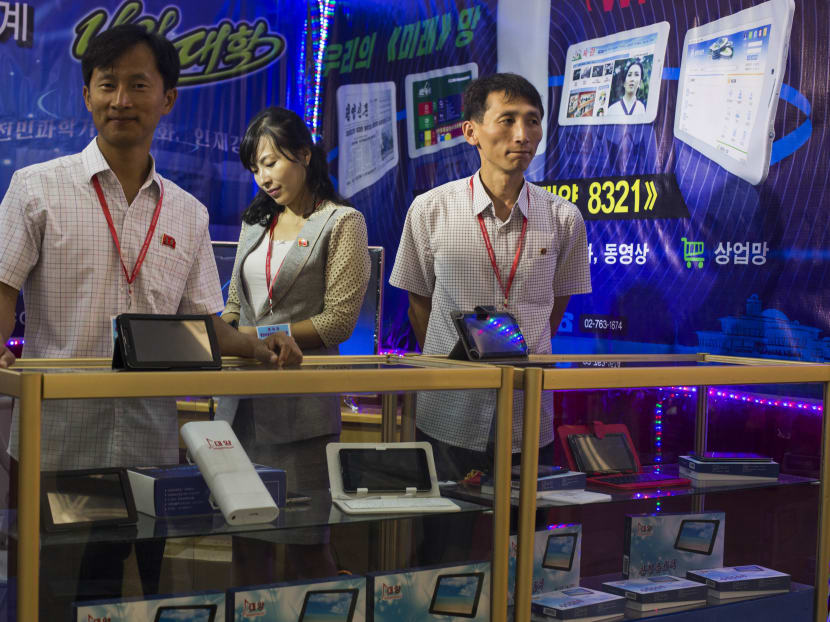
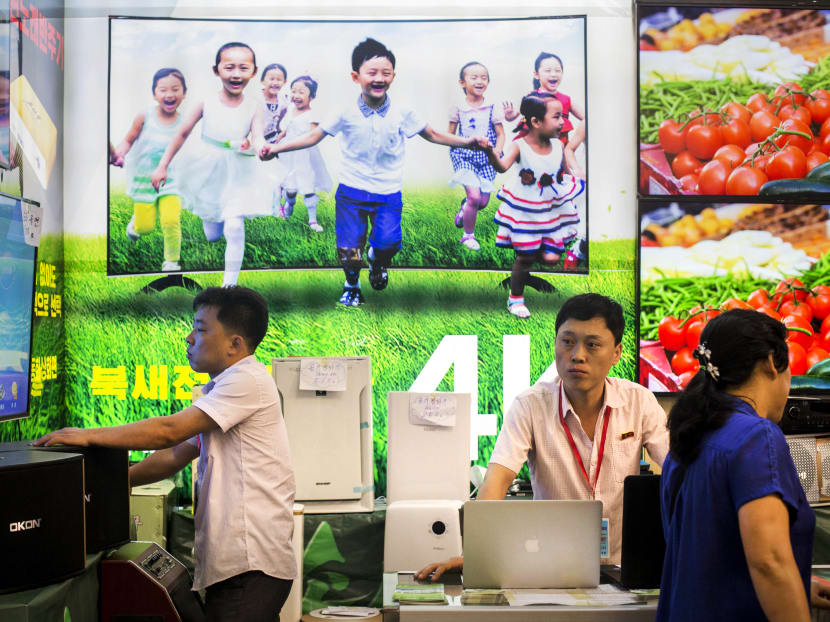
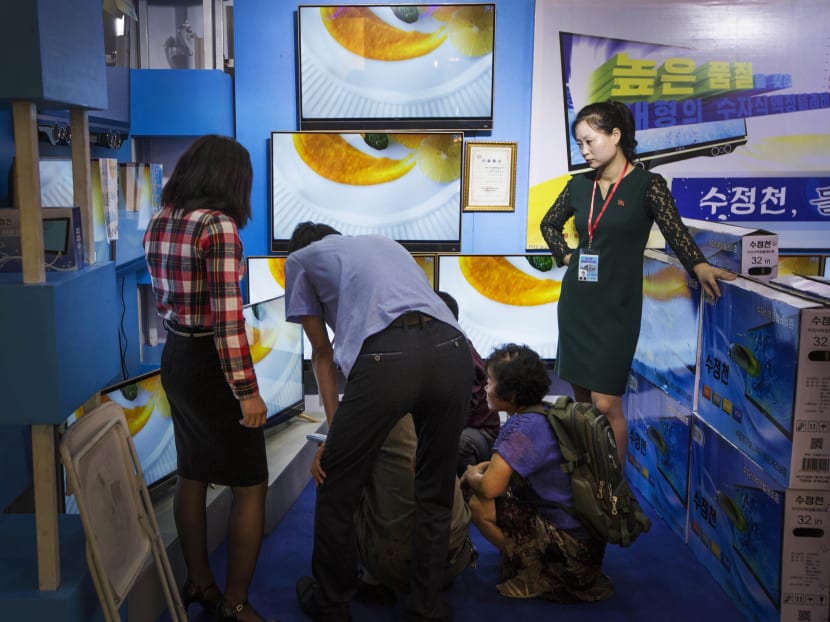
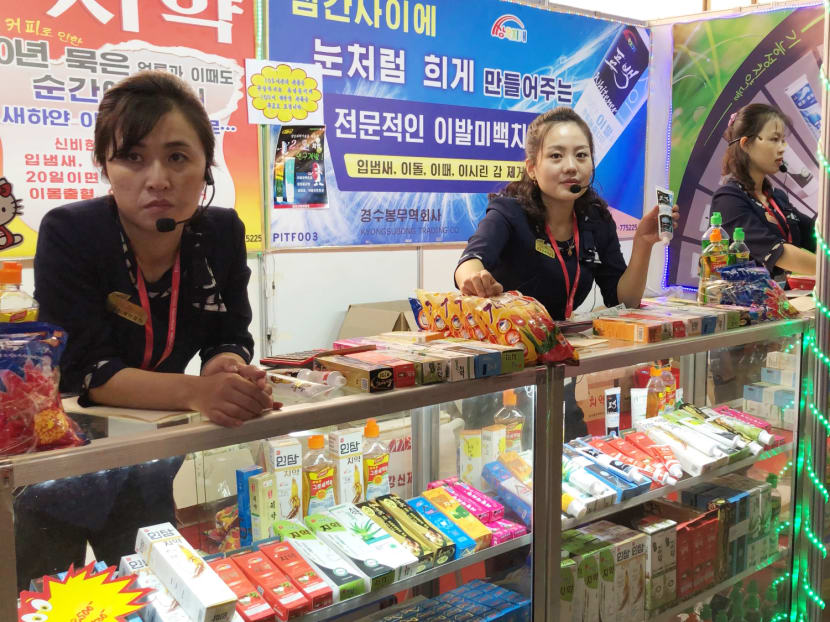
Away from the fair, a four-minute car ride takes one to the city’s tallest inhabited building which appeared on Pyongyang’s skyline just a year ago. The 82-storey luxury condominium is just one of six residential towers on Ryomyong Street, a gleaming new upmarket housing district reportedly built at a cost of 1.7 billion won (S$258 million). Its development came just two years after a posh riverfront district emerged at Mirae Scientist Street, another 15-minute ride away.
Pyongyang’s affluence is also manifested by a sense of individuality that has developed among many North Koreans.
A Ho Chi Minh-based businessman, in his mid-40s, who visited the city last week, told TODAY that the streets are a lot more colourful now, compared to five years ago when he was last in Pyongyang. He noticed that more Koreans had ditched their clothes made of a stiff and dye-resistant homegrown fabric called vinalon – once a national symbol of self-reliance – for softer and bolder-hued fabrics.
As there are no official figures, the most “definitive” indicator of North Korea’s “consumer” market could be the number of Korean subscribers to the country’s only 3G network, Koryolink, which currently stands at more than 3.5 million, said business consultant Michael Heng who led the Singaporean delegation to North Korea on a fact-finding trip. Five years ago, subscription numbers were only nearing two million.
Although North Koreans now use touchscreen smartphones, their affluence level would be better compared to Singapore in the 1980s, when brick phones were still in trend, Dr Heng pointed out.
The Pyongyang streets, dotted with images of the late North Korean leaders Kim Il-sung and Kim Jong-il, reminded him of a bygone “Singapore without Lee Kuan Yew statues”, said the former Nanyang Technological University academic.
Even the “social discipline” which the Singapore founding prime minister instilled in his countrymen — such as the rules relating to no littering and no long hair for males — and helped carry the nation through its second industrial revolution, has its parallels in North Korean society today, he added.
POTEMKIN VILLAGE OR THE REAL THING?
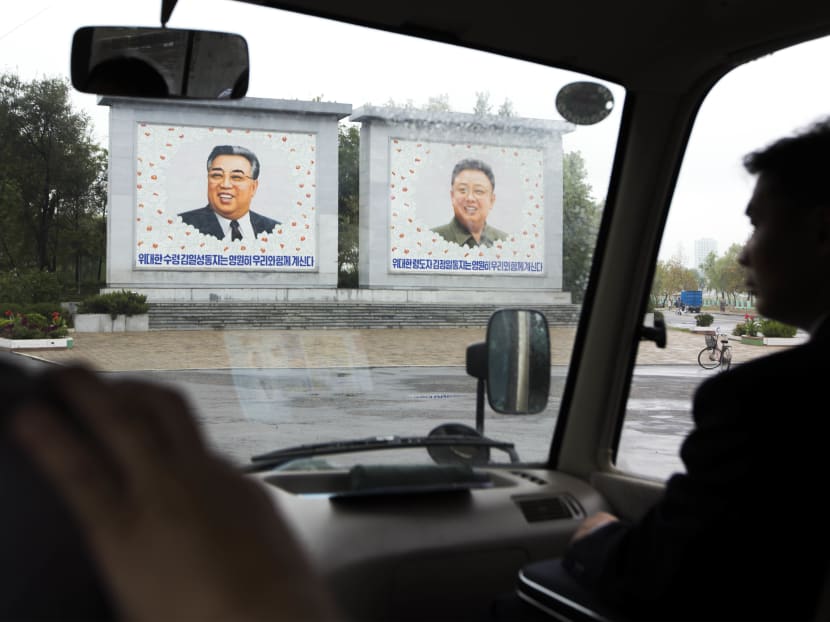
Pyongyang’s display of affluence and consumerism inevitably gives rise to this question: How can a nouveau riche emerge when the country is reeling from international sanctions imposed on North Korea, which are aimed at forcing its government to give up its nuclear weapons programme?
Some experts told TODAY the prosperity seen in Pyongyang could be the result of North Korea opening up more to its limited network of connections – some of whom might be tempted to broker under-the-table deals – despite the rest of the world cutting off trade and economic ties with it.
North Koreans have also benefited from loosened economic regulations under Mr Kim Jong-un’s government, although the extent to which consumer welfare has improved outside the capital remains anyone’s guess, they said.
Smuggling is a “major" activity as there is no broad-based wealth flowing through North Korea, said Dr Nah Liang Tuang, research fellow with the military studies programme at the S Rajaratnam School of International Studies’ (RSIS) Institute of Defence and Strategic Studies.
It is likely be carried out by North Korea’s nascent middle class, known as “donju” or “masters of money”.
Dr Nah said: “These people earn their wealth on the black market, hold hard currency such as the yuan or US dollar and trade in consumer goods smuggled over the Chinese border.
“They continue to function by paying off local officials and Pyongyang tolerates their presence because they act as a commercial ‘safety valve’ for the North Korean economy and they pay taxes to the Kim regime.”
Apart from the black markets, wealth could have been created at officially sanctioned markets that are tacitly allowed to operate as long as vendors pay “taxes” or “rents” to the state, although the economy remains to be largely centrally controlled and state-planned, RSIS Associate Research Fellow Shawn Ho noted.
He was referring to a 2017 and 2018 study by US’ Center for Strategic and International Studies (CSIS), which found that there are at least 436 of such markets in North Korea, and the estimated annual revenue generated for the government comes up to about US$56.8 million.
The study’s analysts, CSIS senior adviser and Korea Chair Victor Cha and CSIS fellow with the Korea Chair Lisa Collins, said the sheer volume and geographic distribution of the markets indicate that they have become “institutionalised” as part of the North Korean society.
The analysts further said that the advent of mobile phone networks within the state’s intranet and closed cellular system since 2002, coupled with the growth of private transportation modes, could have led to a “latent civil society” forming around these markets. This is made possible as “citizens share information, commerce, and further promote growing autonomy of livelihood through these markets”, they wrote.
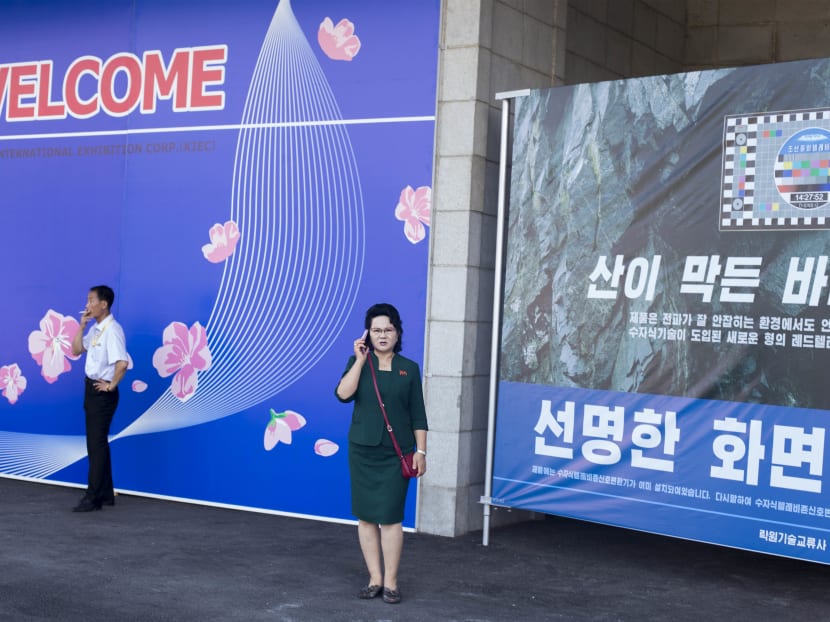
The growth of a nouveau riche could be contributing to greater income disparity, the experts also noted.
“As narrated from my sources, the sanctions are actually making an impact on the societal level outside Pyongyang,” Dr Nah said. “Also, one needs to be cognisant of the fact that truly effective sanctions were only enacted from 2016 onwards (following North Korea’s fourth nuclear test). It will take time for them to produce results.”
As such, Pyongyang, essentially, should be treated as a Potemkin village, Dr Nah added, where the Kim regime places a small minority of the privileged elite in the capital as a showcase, while the country’s true conditions are hidden elsewhere.
The extensive sanctions, passed by the 15-member United Nations (UN) Security Council unanimously against North Korea, cover a ban on exports of coal, iron, lead, textile, seafood, the setting up of joint ventures, as well as removing the right of North Korean nationals to work abroad, among others. North Koreans working overseas have been given two years to return home, effective from December last year.
Dr Huang Chin-Hao, an assistant professor at Yale-NUS College, draws clues of the sanctions’ impact from the way the North Korean government took a diplomatic approach recently to reach out to adversaries by engaging in direct talks with the United States and South Korea “in a bid to solicit external assistance”.
It “reflects a change of tactics to help alleviate the mounting pressure of recent sanctions”, as they become more tightly enforced by key stakeholders, including China from whom the North Koreans get “significant hard currency”, Dr Huang said.
Furthermore, studies have shown that income disparity has been a “perennial challenge” in North Korea, with the country’s Gini coefficient – which ranges from 0 to 1, with one being the most unequal – estimated to lie in the 0.8 range, Dr Huang said.
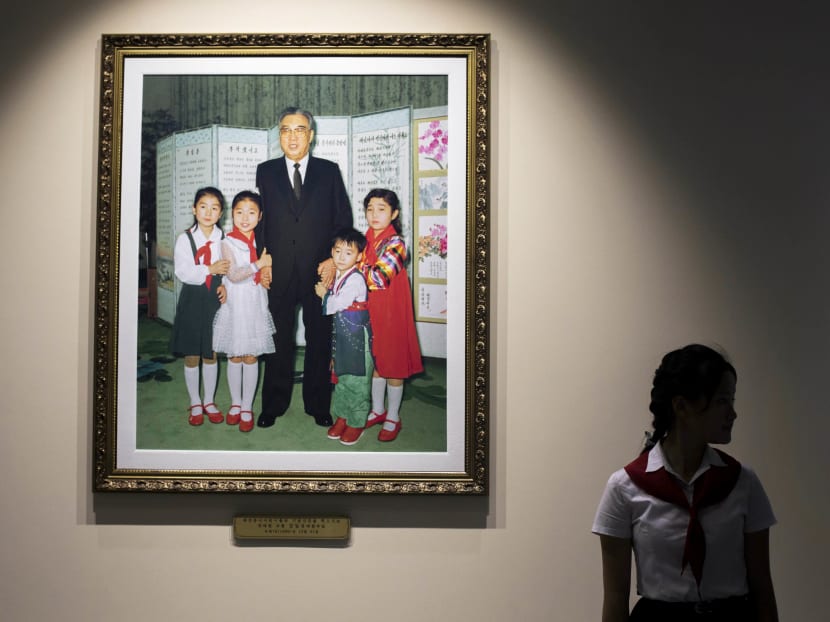
TURNING TO SOUTH-EAST ASIA
While the wider economy has taken a severe beating due to international sanctions, activity at North Korea’s Ministry of External Economic Relations has not come to a halt.
Instead, the ministry has started to beef up North Korea’s ties with South-east Asian countries, even as it maintains its close ties with traditional ally China.
When the visiting Singaporean businessmen met North Korean Vice-Minister of External Economic Relations Ri Myong-san during a courtesy call, he said that his government is “now concentrating efforts in developing the relationship with the neighbouring countries, such as South-east Asian countries”.
In doing that, RSIS’ Mr Ho said North Korea probably recognises that it is important for any kind of government or company to diversify. “No one wants to be overly dependent on another partner or source. And their thinking is (the more) friends, connections, partnerships around the world, the better,” he told TODAY.
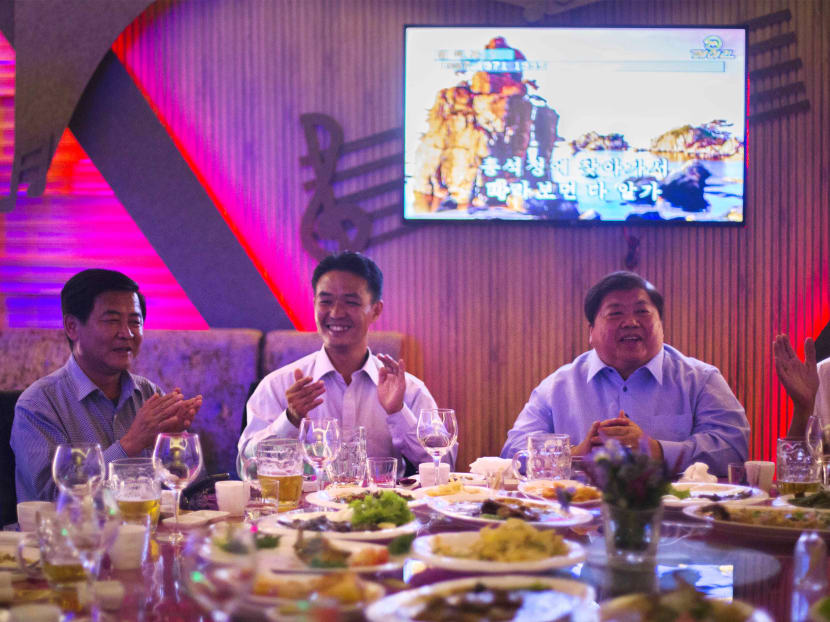
South-east Asia was probably singled out as all 10 members of the Association of Southeast Asian Nations (Asean) have diplomatic relations with North Korea, some of which go back a long way to the 60s and 70s. “It’s not that we just got to know each other yesterday,” Mr Ho said.
North Korea’s friendly gestures towards Singapore and the rest of South-east Asia could also be due to Asean’s own approach that “it is always good to engage rather than isolate”, said Mr Ho.
By keeping the channels of communication open, the North Koreans probably feel that South-east Asian countries “give them a certain degree of respect”, having received the same level of treatment as other countries, he said.
With diplomatic ties established since Nov 8, 1975, Singapore is one such South-east Asian country which has long-standing contacts with North Korea – a fact Mr Ri acknowledged too, calling the relationship “time-honoured”.
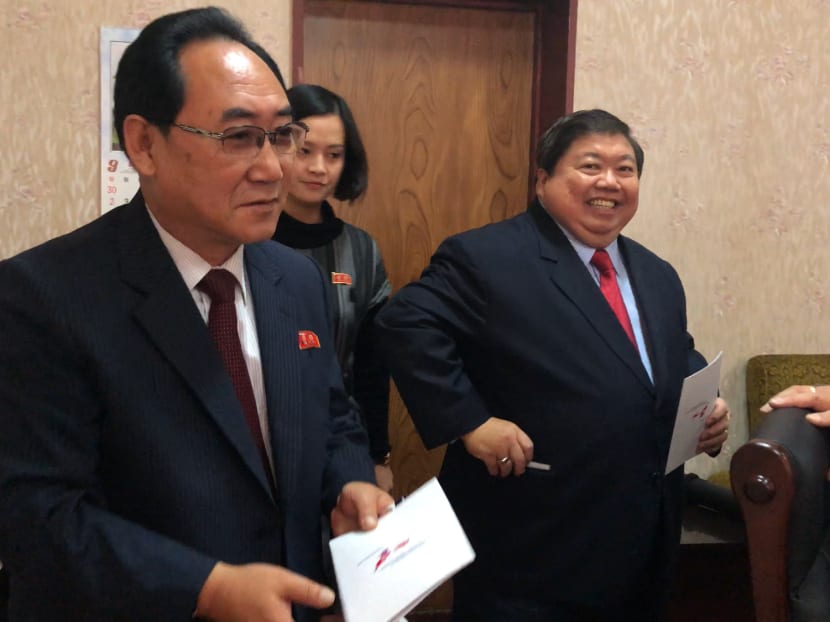
Despite the suspension of trade relations between the two countries since November last year, North Korea maintains an embassy in Singapore.
According to the Korea Foreign Investment and Economic Cooperation Committee, Singapore was the last of 18 countries to enter into an investment promotion and protection agreement with North Korea. It was inked on Feb 12, 2008 between Singapore and North Korea.
Denmark was the first country to have signed the agreement in Sept 10, 1996, followed by Nigeria and Russia in November that year.
However, Singapore does not share an agreement on the avoidance of double taxation, which 15 countries have signed.
DEALS UP FOR GRABS… WHEN SANCTIONS ARE LIFTED
Building bridges with South-east Asian countries aside, the North Korean government and committees linked to the ruling party are also taking the time to learn the ropes on how to manage the relatively foreign concept of investors and joint ventures from trusted individuals and associations, who are also eager to avoid the mistakes made in their past dealings in North Korea.
Meanwhile, the parties which have been engaging in talks with North Korea are eyeing projects that would be immediately up for grabs once the international sanctions are lifted.
One such party is Dr Heng who returned home from North Korea with 18 investment-ready projects worth more than US$2 billion in total.
The projects range from a US$5.55 million tourist bus station in Wonsan, an up-and-coming tourist zone which will soon be served by a dedicated airport next year, to the development of an industrial park in Jindo, within the port town of Nampo, which might require an investment of up to US$1 billion.
As for the Pyongyang trade fair which saw exhibitor demand exceeding capacity, Mr Pak Chol-jin, business development manager of Korea International Exhibition Corporation which organises the fair, is also consulting Dr Heng on their plans to construct a new US$250-million expo and convention hall at a site close to the current Three Revolution Exhibition hall that was used for the fair.

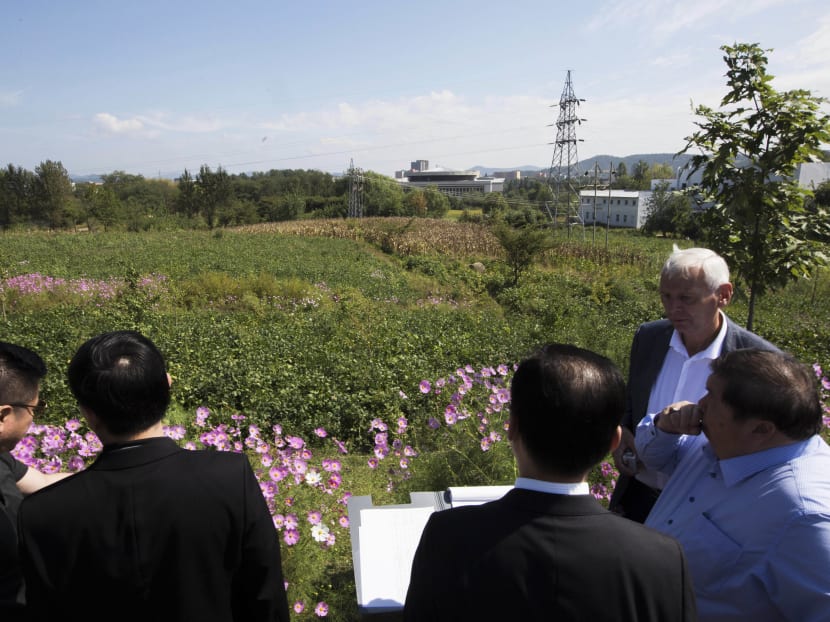
The project is aimed at tripling its current capacity of booths in a three-storey building, with plans to integrate it with a 30-storey hotel catered for businessmen and a showcase for export goods, among others.
Dr Heng, a consultant with experience in the Chinese and Vietnam markets, said the investment projects discussed during the Singapore’s delegation visit was “possibly the largest number by any business mission from Singapore to any country”.
TODAY understands that North Korea will receive another delegation made up of Singapore-China Business Association members next month, and other projects could be presented.
North Korea-prepared project proposals seen by TODAY offered details to the point of listing estimated costs and profitability analyses. There is also a breakdown of the payback periods – the biggest bugbear for any investor dealing with North Korea, where profit repatriation could be a big problem, and legal safeguards surrounding it are loose, relying heavily on an arbitration centre ruled by its own people.
After all, there had been a few examples in which investors could not take out their profits, the most famous of which being the case of Koryolink. Its joint venture partner, Egyptian company Orascom, repeatedly faced issues in extracting its profits from North Korea due to the new sanctions regime. Businessmen are still watching developments closely, as Orascom was just granted an exemption from the United Nations to operate its North Korean venture last Sunday (Sept 23).
Mr Ri assured the Singaporean delegation that there are plus points in investing in North Korea — a reliable labour force, and the fact that the country is the “most stable” although the situation is "very tense” on the Korean peninsula.
He added: “The Korean people are good on credit because they are kind-hearted and very conscious. So they know that if they put their funds here, it is very safe.”
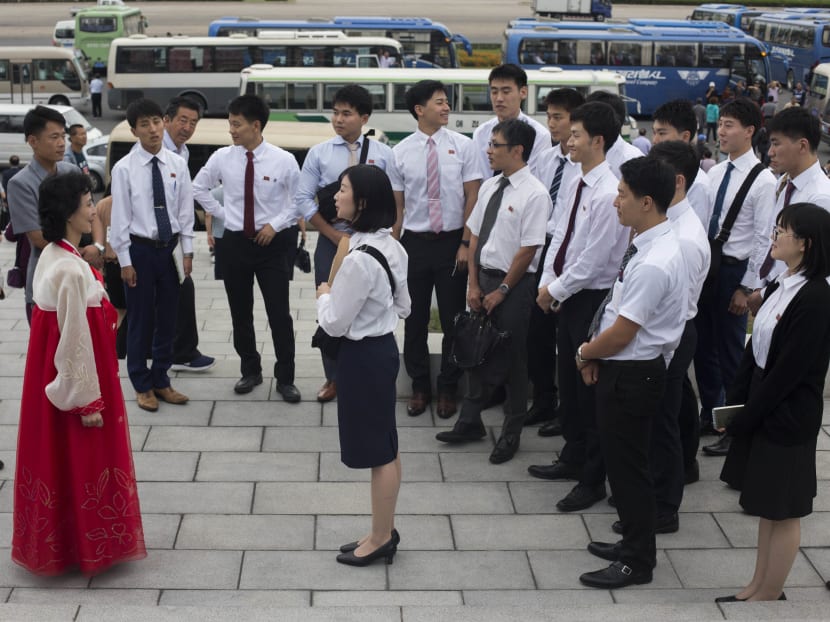
Mr Ri Jun Ho, from the department of investment promotion of Korea Foreign Investment and Economic Cooperation Committee, also addressed the point in a separate meeting with the businessmen.
“The DPRK (Democratic People's Republic of Korea) government permits you to acquire legal and rational profit in the DPRK,” he said. “No matter how much profit the foreign-invested enterprise may get, the investor can acquire the profit according to the investment rate in the contract, and remit in accordance with the foreign currency management regulations.”
A few businessmen who spoke to TODAY on the condition of anonymity said they need the assurance that the deals inked would be done with the protection of international arbitration centres for a fairer conflict resolution process.
NOT WITHOUT RISKS
The window of opportunity for Singapore in North Korea might not be open for long. Mr Ri revealed that “a lot of countries are suggesting that they would invest in our country”.
Dr Heng noted that North Korea had been a corporate graveyard for many foreign investors. But he added that the mistakes of the “early corporate martyrs” could be prevented now that Singapore has the luxury of time — with the sanctions still in place and not likely to be lifted so soon — to ponder over a better mode of collaboration with North Korea.
The culture of the Koreans, for instance, cannot be ignored, he said, pointing to the North Koreans’ ideology of “juche”, or self-reliance.
“(The early entrants) came in, brought in the capital and dominated the joint venture… Self-reliance could not have allowed them (North Koreans) to take in a foreign investor and make him the new lord over their lives. They would not allow that.”

Foreign investors must make the North Koreans feel that they are taking the lead, added Dr Heng.
After all, he added: “These are people who had felt persecuted, who feel that this world had abandoned them, left them, their friends do not acknowledge them openly, even vote against them in sanctions, then they come around and want to work with them. You put yourself in the shoes of the North Koreans. How would you feel?”
Dr Heng also said that North Korea, if Singapore gets involved, will be a market that consolidates all the lessons of the past, from Vietnam to China, except that North Korea is already at an advanced stage in terms of infrastructure and education.
“North Korea has nearly 100 per cent literacy rate…The schools have also enabled them to be more productive, thus being able to contribute to the country’s goals (and) they have been doing these for the past 20 over years,” he said.
An Italian academic who attended a conference at Pyongyang’s Kim Chaek University of Technology last week, said some of the North Koreans he met did not seem to be too interested in nuclear issues.
Professor Luca Cedola, from Sapienza Università di Roma’s mechanical and aerospace engineering department, said the North Koreans showed him that they were more eager to “make friendship and be part of the international research community”, perhaps because “doing research alone is quite difficult”.
“They do not have access to research in other countries. (It’s like) you are working on developing alternative fuel and you don’t know what the others are doing,” said the 49-year-old expert in energy smart grids.
Even so, Prof Cedola observed that the North Koreans are “doing almost the same things” as the world in the renewables field. “The moment they are connected, they are ready to be part of the full research community. The young ones are brilliant. The level of English is perfect. It’s like being in any other international conference, but the (funny thing) is they haven’t been in any,” he said.

But will North Korea’s openness to the outside world lead to political reforms on the part of an oppressive regime? Experts are optimistic, but noted that the process will be gradual.
Said Dr Huang: “The regime’s ultimate concern is to retain political control. Opening up too quickly risks undermining the regime’s ability to exert its influence, so any kind of international rapprochement will be carefully negotiated to extract maximum benefits, all the while minimising any potential risks to the regime.”
Dr Nah noted that one of Mr Kim’s national ideologies is “byungin”, where the North has a booming economy, yet retains its nuclear weapons. Its nuclear programme is, and will remain, the sole reason the world keeps North Korea at a distance and treats it as a “pariah state”.
“If the North is prepared to verifiably and permanently give up its nuclear weapons and long-range missiles, I won't be surprised if the international community in general, (minus Western liberal democracies) would be willing to do business with North Korea, even as the Kim regime remains as harsh and authoritarian,” said Dr Nah.
Despite the numerous challenges that await investors in North Korea, given the international sanctions and the internal political situation, there are still people who are prepared to take the risk. One of them told TODAY: “In chaos, there is profit.”









